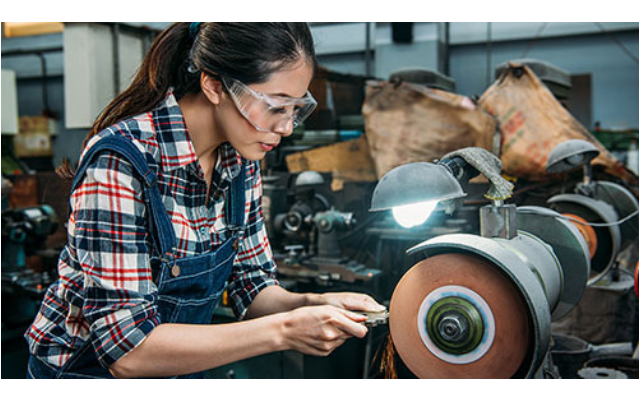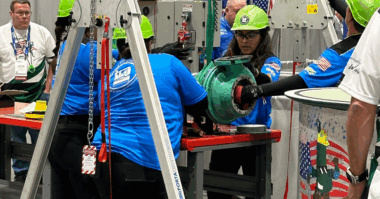Contributor: Kristin Graybill, Vice President of Communications, Marketing & Sales for the Manufacturers Alliance for Productivity and Innovation
Women make up 47.5% of the overall workforce but a mere 29% in manufacturing – a percentage roughly unchanged since the 1970s, according to the Census Bureau. As manufacturing jobs increasingly rely on advanced technology, will the demand for STEM skills further widen the gap for women in the manufacturing workforce? Is manufacturing really destined to be a man’s world?
Overall, women represent only 22% of the STEM workforce and only 16% of patent grants. A U.S. Department of Commerce report confirms that “while women continue to make gains across the broader economy, they remain underrepresented in STEM jobs and among STEM degree holders.” Gender achievement gaps in STEM fields have narrowed, but women still lag men, completing only 35% of degrees related to a core science, technology, engineering, or mathematics discipline.
The gender gap with STEM isn’t only an issue of equality; it affects the economy. How many inventions could advance our world if women had more seats at the table in innovative fields? A great deal of work remains to realize this untapped potential.
However, we see three positive opportunity areas – in legislation, school systems, and workplace initiatives – to help close the gender gap by solving today’s STEM imbalance.
Setting the Right Example (and Law) Through Legislation
Last year the President signed two bills into law to encourage more women to join STEM fields.
The Inspiring the Next Space Pioneers, Innovators, Researchers, and Explorers (INSPIRE) Women Act (Inspire Act) directs NASA to encourage women and girls to pursue careers in aerospace. It gave NASA three months to present plans to get in front of girls studying STEM to promote aerospace careers, adding to robust mentorship programs in place for children. This builds on the Women of NASA Lego set that went into production after over 10,000 supporters backed the set following the release of the movie Hidden Figures.
Promoting Women in Entrepreneurship Act authorizes the National Science Foundation to support entrepreneurial efforts focused for women. President Trump commented, “It’s not fair and it’s not even smart,” when discussing the small amount of women with STEM degrees working in a STEM field. Research based on patent activity from Michigan State notes that women are as likely as men to commercialize ideas, acknowledging that when the opportunity is there, it benefits women and the economy.
Hopefully impactful legislation will continue to follow.
Removing Biases from Education
For our early learners, leaders are working to find ways to tackle unconscious gender bias in early education, as it affects student choices in secondary schools. For example, the College Board found that only 23% of students who took the AP computer science exam were female, which mirrors the percentages of women in those fields in the workforce. The Girl Scouts of the USA introduced a National Cybersecurity Badge in 2017, which teaches how to protect identities online and safeguard systems, and also introduces young learners to new ideas in the area of STEM.
The American Association of University Women offers six ways to help increase girls’ and women’s engagement in STEM:
- Emphasize STEM skills in early education, K–12, and higher education.
- Expose girls to female role models in STEM and encourage high school girls to take calculus, physics, chemistry, computer science, and engineering classes.
- Include in teacher training: recognition and avoidance of implicit gender bias, awareness of stereotype threat, techniques to improve spatial skills, and ways to promote a growth mind-set.
- Measure student achievement in STEM disaggregated and cross-tabulated by gender.
- Actively recruit women into STEM majors.
- Enforce Title IX to improve school climates for women and girls.
Making Inroads with Workplace Initiatives
Manufacturers across the board have had limited success increasing women and other minority participation in the manufacturing workforce, but it’s not from a lack of trying. In a 2016 MAPI study, 2/3 of surveyed manufacturing companies said they have a long-term focus on supporting diversity and inclusion (D&I), including implementation of D&I strategies to recruit, engage, and retain minority employees. But, the troubling news is that only 25% of those business leaders believe that their investments have been effective. (MAPI is undertaking a follow-up D&I study, expected to publish in the spring, that will hopefully shed light on any improvement in the manufacturing industry.)
Some companies are going the extra mile to improve D&I. GE announced its plans to hire 20,000 women in STEM areas. Thirty tech companies signed the White House’s pledge to D&I back in 2016, which has now grown to over 80 companies, but benchmarks for success were left to individual organizations. In an article with Forbes, SAP’s chief diversity and inclusion officer noted “Coming from an economics background, I believe what gets measured is what gets done. Diversity and inclusion is important to us and we want to be transparent.”
While this is in no way a comprehensive reporting of the direct and indirect issues surrounding equity for women in the workplace, I’m heartened by efforts to create more equal opportunities. Industry data and experiences do remain deeply concerning, but recent actions offer much-needed encouragement that progress is possible.
*This article was originally published on MAPI.net.




